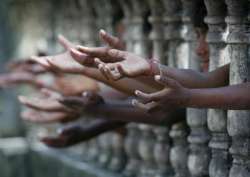Half of India's under-18 population lives in poverty: Study
The international definition of a child, used in the study, was anyone less than 18 years of age.

At least half of India's under-18 population lives in acute poverty, reveals a "deeply disturbing" study from Oxford University.
Across the 103 low and middle income countries surveyed, children were found to constitute 34 per cent of the total population, but 48 per cent of the poor, based on a measure that assesses a range of deprivations in health, education and living standards.
The international definition of a child, used in the study, was anyone less than 18 years of age.
"These new results are deeply disturbing as they show that children are disproportionately poor when the different dimensions of poverty are measured," said Sabina Alkire, Director of Oxford Poverty & Human Development Initiative (OPHI) at the University of Oxford.
The research examined the latest figures for the Global Multidimensional Poverty Index (MPI) by age group to analyse the particular situation of 1.8 billion children who live in 103 countries.
MPI complements traditional income-based poverty measures by capturing the severe deprivations that each person faces at the same time with respect to education, health and living standards.
The MPI assesses poverty at the individual level. If someone is deprived in a third or more of ten (weighted) indicators -- nutrition, child mortality, years of schooling, school attendance, cooking fuel, improved sanitation, safe drinking water, electricity, flooring, assets -- the global index identifies them as "MPI poor".
The extent -- or intensity -- of their poverty is measured by the number of deprivations they are experiencing.
According to the OPHI, nearly two out of every five children -- a total of 689 million children -- are classed as multi-dimensionally poor.
Half of South Asia's children and two thirds of Sub-Saharan children are multi-dimensionally poor, according to the study.
In 36 countries, including India, at least half of all children are MPI poor.
The condition of children is worse in Ethiopia, Niger and South Sudan where over 90 per cent of all children are MPI poor, according to the study which highlights the challenges that the UN's new Sustainable Development Goals for the eradication of child poverty face.
"This is a wake-up call to the international community which has adopted the global Sustainable Development Goals and takes seriously Goal 1, the eradication of poverty in all its forms and dimensions," Alkire said in a news release.
"Children are our future workers, parents and citizen/voters. Investing in them brings benefits now and also in the future," Alkire added.